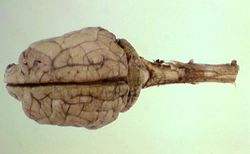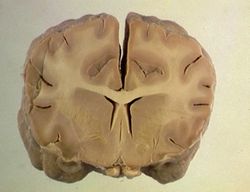Spinal Cord - Anatomy & Physiology
Introduction
The spinal cord can be divided to several regions; cervical (C1-C6), cervicothoracic (C7-T2), thoracolumbar (T3-L3), lumbosacral (L3-S2) and sacral (S3 onwards). Nerves originating from the spinal cord and the segmental spinal nerves innervate the limbs.
The forelimb nerves include the suprascapular (C5-6), the musculocutaneous (C5-7), the ulna/median (Originates from the brachial plexus, which is formed from C5-T1) and the radial (C5-T1). The hindlimb nerves include the obturator (L2-4), the femoral (L2-4) and the sciatic (L4-S3). The sciatic nerve branches to the tibial nerve and the peroneal nerve.
Structure and Function
The spinal cordis constructed of the marginal layer which has axons and white matter, the mantle which contains cell bodies and grey matter and the spinal canal. This canal conducts sensory information from the peripheral nervous system (both somatic and autonomic) to the brain, conducts motor information from the brain to various effectors and acts as a minor reflex center.
Function
Components
The central nervous system consists of; the brain (Prefix = "encephalo") and the spinal cord (Prefix = "myelo").
Function
Sensory neurons from both the internal and external environment relay information to the CNS. The CNS processes sensory information and intitiates motor outputs. Effector and motor neurons from the CNS relay the appropriate outputs to effector organs.
The Autonomic Nervous System
The autonomic nervous system relays sensory information from, and motor information to, the internal environment. It therefore plays an important role in the maintenance of homeostasis.
The Somatosensory Nervous System
The somatosensory nervous system relays sensory information from, and motor information to, the external environment.
White and Grey Matter
White Matter
White matter consists of accumulations of myelinated axons. Myelinated axons are wrapped in myelin. Myelin is compsed of lipid and protein in an 80:20 ratio. It insulates axons to give efficient action potential conduction. Myelin is provided by oligodendrocytes in the CNS. They respond poorly in injury. Schwann cells in the PNS myelinate one axon only. A "funiculus" is a large region of white matter in the spinal cord.
Grey Matter
The outer portions of the cerebral cortex and the inner portions of the spinal cord are composed of grey matter. Grey matter is also found in coloumns and scattered in brainstem nuclei. It is composed of neuronal cell bodies, plus glial cells.
Upper and Lower Motor Neurons
Lower Motor Neuron (LMN)
LMNs are efferent neurons which connect the CNS to smooth or skeletal muscle. Autonomic LMNs connect to smooth muscle. Somatic LMNs connect to skeletal muscle. Those innervating the muscles of the axial and peripheral skeleton have their cells bodies in the ventral horn of the spinal cord. Injury causes LMN weakness. This is characterised by; Depressed reflexes, decreased tone and neurogenic muscle atrophy.
Upper Motor Neuron (UMN)
The upper motor neuron comprises the motor system of the CNS. This is responsible for; Initiating voluntary movement and maintenance of tone and posture. In man, direct connections exist between neurons in the motor cortex and LMNs in the spinal cord. This is known as the "pyramidal system". In animals, there are scattered groups of interconnected neurons in the cortex and brainstem, which ultimately synapse with LMNs in the brainstem and spinal cord. This is called the "extrapyramidal system". UMN injury results in increased extensor tone, giving; Stiffness, spasticity, delay in the onset of protraction, and a longer stride, disinhibition of the LMN relfex ability, causing increased reflexes, the inability to stimulate the LMN and UMN weakness results.
Vasculature
It is important to note that there is no direct vasculature to the spinal cord but instead there are a number of choroid plexuses that act as an exchanger between the vasculature of the spinal cord/brain and the fluid surrounding these structures. This distinction is referred to as the "blood-brain barrier".
The vasculature of the spinal cord has a close relationship with the cerebrospinal fluid (CSF) within the subarachnoid space. This CSF effectively forms a water jacket that buoys up the spinal cord and protects it from external influences. Therefore it is extremely important that the CSF has the appropriate properties in order to undertake this role. The vasculature of the spinal cord therefore has to provide the appropriate level of oxygen, pressure, pH and nutrients to maintain homeostasis of the spinal cord. As the CSF also performs this role within the skull, the vasculature of the brain therefore has an important relationship with every aspect of the ventricles and subarachnoid space within the central nervous system.
For more detailed information on CSF, please see CSF Physiology.
Arterial Supply
The spinal cord is supplied by three main arteries that run along its length; the Ventral Spinal Artery, and paired dorsolateral spinal arteries. The ventral spinal artery is the largest and follows the ventral fissure of the spinal cord. The dorsolateral arteries run close to the groove from which the dorsal nerve roots arise. Together with these three main arteries, the spinal cord is also supplied by branches from regional arteries including branches in the cervical, intercostal, lumbar and sacral regions. These regional arteries enter the spine at the intervertebral foramina, often accompanying the roots of spinal nerves. These regional arteries also form plexuses into which the three main longitudinal arteries run.
Innervation
Lymphatics
Histology
Species Differences
Links
| This article is still under construction. |

